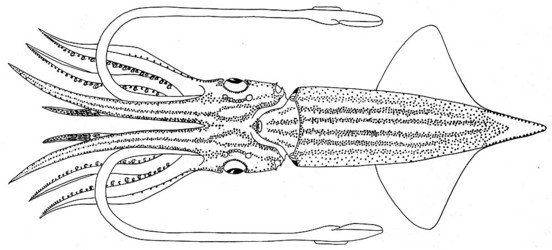Enoploteuthis anapsis
Kotaro TsuchiyaIntroduction
Enoploteuthis anapsis, a relatively small species for the genus, attains 70mm DML. This species is widely distributed in the tropical to warm temperate Atlantic. This is the only species in the genus that is restricted to the Atlantic Ocean. This species is similar to E. jonesi and E. higginsi from the Pacific Ocean in the general photophore patterns.
Characteristics
- Tentacle
- Tentacle long, with distinct club.
- Carpal cluster oval.
- Two rows of different-sized hooks on manus.
- Four rows of suckers on dactylus.
- Hectocotylus
- Hectocotylus with two flaps; large truncate proximal flap and short semicircular distal one.
- Modified portion with armature.
- Distal suckers lost in fully mature male.
- Integumental Photophores
- Ventral mantle with six longitudinal stripes of integumental organs anteriorly; stripes diffuse posteriorly.
- Ventral head with two ring-like patterns of integumental photophores.
- Ventral side of arm III with a series of organs to the middle of arm length along the base of aboral keel.
 Click on an image to view larger version & data in a new window
Click on an image to view larger version & data in a new window
Figure. E. anapsis. Ventral view showing arrangement of photophores. Photograph by M. Vecchione
Distribution
Vertical distribution
Specimens between 15-79mm DML were collected at 0-130m at night (Roper, 1966).
Geographical distribution
This species is the only species in the genus that is endemic species to the Atlantic. It is widely distributed the tropical to warm temperate waters between 40° N - 40° S (Roper, 1966).
References
Roper, C.F.E., 1964. Enoploteuthis anapsis, a new species of enoploteuthid squid (Cephalopoda: Oegopsida) from the Atlantic Ocean. Bulletin of Marine Science of Gulf and Caribbean, 14:140-148.
Roper, C.F.E., 1966. A study of the genus Enoploteuthis (Cephalopoda: Oegopsida) in the Atlantic Ocean with a description of the type species, E. leptura (Leach, 1817). Dana Report, 66:1-46.
Tsuchiya, K. 2000. Illustrated book of the Enoploteuthidae. In: Okutani T., ed. True face of Watasenia scintillans. Tokai University Press, Tokyo, p 196–269. (in Japanese)
Title Illustrations

| Scientific Name | Enoploteuthis anapsis |
|---|---|
| Location | Caribbean Sea |
| Reference | Roper, C.F.E., 1964. Enoploteuthis anapsis, a new species of enoploteuthid squid (Cephalopoda: Oegopsida) from the Atlantic Ocean. Bulletin of Marine Science of Gulf and Caribbean, 14:140-148. P.142, Fig. 1. |
| Creator | C.F.E. Roper |
| Sex | Female |
| View | Ventral |
| Size | 63 mm ML |
| Type | Holotype |
| Copyright | © Bulletin of Marine Science |
About This Page
Drawings from Roper (1964) printed with the Permission of the Bulletin of Marine Science.

Tokyo University of Fisheries, Tokyo, Japan
Page copyright © 2018
All Rights Reserved.
- Content changed 29 March 2018
Citing this page:
Tsuchiya, Kotaro. 2018. Enoploteuthis anapsis . Version 29 March 2018 (under construction). http://tolweb.org/Enoploteuthis_anapsis/19705/2018.03.29 in The Tree of Life Web Project, http://tolweb.org/










 Go to quick links
Go to quick search
Go to navigation for this section of the ToL site
Go to detailed links for the ToL site
Go to quick links
Go to quick search
Go to navigation for this section of the ToL site
Go to detailed links for the ToL site